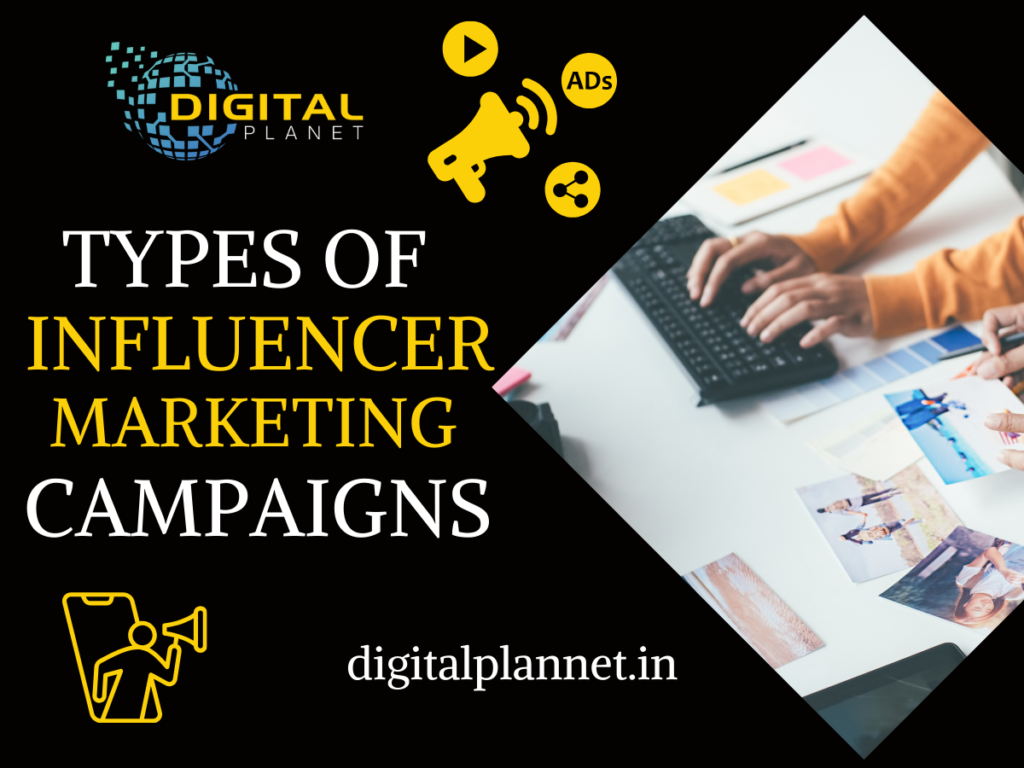Types of Influencer Marketing Campaigns:

Influencer marketing has become one of the most effective ways to drive brand awareness, engagement, and conversions in today’s digital world. With a wide range of options to explore, businesses must choose the right type of influencer marketing campaign to align with their objectives, target audience, and budget. In this comprehensive guide, we will explore the different types of influencer marketing campaigns and how each can help brands achieve their marketing goals.
1. Sponsored Content Campaigns:
Sponsored content is one of the most common types of influencer marketing campaigns. In this type of campaign, influencers create and post content that promotes a brand, product, or service in exchange for payment or a product/service exchange. The goal is to introduce the influencer’s audience to the brand in an authentic and relatable way.
Key Benefits:
Boosts brand visibility by reaching a wider audience.
Allows brands to leverage the trust and authority influencers have with their followers.
Influencers can customize the content to match their style, making the promotion feel more organic.
Best for:
Brands seeking to generate brand awareness and promote specific products or services in a natural, less intrusive way.
2. Product Review Campaigns:
In a product review campaign, influencers receive a product or service from a brand, try it out, and then share their honest opinion with their audience. These reviews can be in the form of blog posts, YouTube videos, or social media posts. Product review campaigns work especially well for companies with new product launches or businesses seeking social proof.
Key Benefits:
Builds credibility by having trusted influencers review products.
Influencers offer honest feedback, which is highly valued by their followers.
Encourages user-generated content and brand mentions.
Best for:
Brands launching new products or those looking to gain social proof and increase consumer trust through authentic influencer feedback.
3. Giveaway and Contest Campaigns:
Giveaways and contests are interactive types of influencer marketing campaigns where brands collaborate with influencers to host a giveaway of their product or service. Typically, followers must engage with the influencer’s content by liking, sharing, or commenting to participate in the giveaway. This campaign type drives high engagement rates and increases brand exposure.
Key Benefits:
Boosts engagement and audience interaction.
Increases follower growth for both the influencer and the brand.
Creates a buzz around the brand and product.
Best for:
Brands looking to increase brand visibility and social media engagement quickly while growing their follower base.
4. Affiliate Marketing Campaigns:
Affiliate marketing campaigns focus on performance-based partnerships between brands and influencers. In this type of campaign, influencers share unique affiliate links or discount codes with their audience. They earn a commission for each sale or lead generated through their promotion.
Key Benefits:
Directly drives sales or leads, making it one of the most measurable types of influencer marketing campaigns.
Only pay for actual conversions, ensuring a high return on investment (ROI).
Allows influencers to create authentic content while promoting products they genuinely use or believe in.
Best for:
E-commerce brands or businesses that want to increase sales while tracking the performance of each influencer involved in the campaign.
5. Brand Ambassador Campaigns:
A brand ambassador campaign is a long-term partnership where influencers represent a brand over an extended period. Brand ambassadors continuously promote the brand and its products or services across their social media channels, blogs, or even offline events. This type of campaign helps build a strong, consistent brand image and deepens the relationship between the brand and its audience.
Key Benefits:
Creates long-term trust and loyalty with the influencer’s audience.
Consistent exposure leads to greater brand recognition.
Enables a deeper connection with consumers through ongoing advocacy.
Best for:
Brands looking for long-term relationships with influencers to drive brand loyalty, awareness, and consistent messaging.
6. Social Media Takeover Campaigns:
In a social media takeover, an influencer temporarily “takes over” a brand’s social media account (such as Instagram or Twitter) for a day or week. During this period, the influencer posts content, interacts with followers, and shares behind-the-scenes glimpses. Social media takeovers can create excitement and build engagement while showcasing the brand from the influencer’s perspective.
Key Benefits:
Fresh content from a different perspective energizes the brand’s social media presence.
Increases engagement and follower interaction.
Builds a direct connection between the influencer and the brand’s audience.
Best for:
Brands looking to refresh their social media presence and connect with new audiences in an interactive way.
7. Event or Experience Campaigns:
Event-based influencer campaigns involve inviting influencers to attend brand-sponsored events, such as product launches, industry conferences, or experiential marketing events. Influencers share their experiences with their followers through live posts, stories, and videos, creating a real-time buzz for the brand.
Key Benefits:
Creates real-time excitement and hype around a brand event.
Provides influencers with unique, authentic experiences to share with their followers.
Encourages followers to engage with the brand by experiencing it through the influencer’s eyes.
Best for:
Brands that want to generate buzz and excitement around events, product launches, or unique brand experiences.
8. Unboxing Campaigns:
Unboxing campaigns involve influencers sharing videos or posts that feature the unpacking and first impressions of a brand’s product. These campaigns are particularly popular on platforms like YouTube and Instagram. Unboxing videos provide a detailed look at the product, its packaging, and the influencer’s initial reactions.
Key Benefits:
Offers a detailed, visual presentation of the product.
Builds excitement and curiosity about the product.
Increases brand trust through real, unedited first impressions.
Best for:
Brands launching new products or companies that want to showcase the quality of their packaging and product details.
9. Discount or Promo Code Campaigns:
Promo code campaigns incentivize followers by offering exclusive discounts when purchasing products using a special influencer-provided code. This type of campaign is highly effective in driving immediate conversions, as followers are motivated by the exclusive offer.
Key Benefits:
Drives immediate sales and conversions.
Easy to track the effectiveness of the campaign through code usage.
Creates a sense of exclusivity for the influencer’s audience.
Best for:
Brands looking to drive quick sales and incentivize followers to purchase their products.
10. Guest Blogging Campaigns:
Guest blogging involves influencers writing blog posts or articles for a brand’s website. These posts allow influencers to share their expertise, offer recommendations, and create content that aligns with the brand’s objectives. In exchange, influencers benefit from additional exposure and credibility.
Key Benefits:
Generates high-quality content for the brand’s website.
Helps with SEO by improving the website’s content quality and relevance.
Builds authority and trust with the audience by leveraging the influencer’s expertise.
Best for:
Brands aiming to improve their content marketing strategy and boost SEO while providing valuable information to their audience.
Conclusion:
In conclusion, choosing the right type of influencer marketing campaign depends on your brand’s goals, target audience, and budget. By carefully selecting the most suitable campaign type, businesses can effectively engage with their audience, increase brand awareness, and drive conversions. Whether it’s a one-off sponsored post or a long-term ambassador partnership, influencer marketing can be a powerful tool for modern brands.
Related Posts
- Best AI for Video Generation Free 2025: Ultimate Guide + Top Picks
- How to Get Invite Code for Sora 2 (2025): The Ultimate Step-by-Step Guide
- Influencer Marketing for Travel Industry 2025
- Top 10 Motivational YouTubers in India-Must Follow in 2025
- Boosting Health & Fitness Brands with Influencer & UGC Marketing
